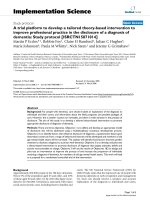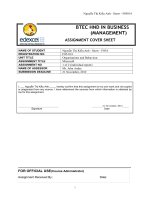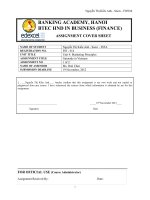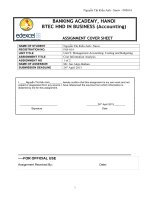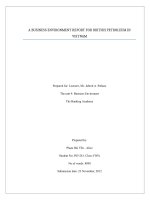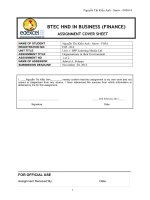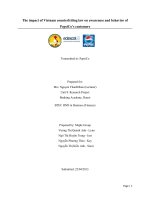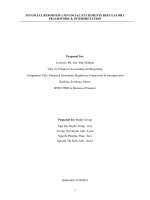Assignment 1 1620 Professional Practice Distinction
Bạn đang xem bản rút gọn của tài liệu. Xem và tải ngay bản đầy đủ của tài liệu tại đây (5.11 MB, 58 trang )
ASSIGNMENT 1 FRONT SHEET
Qualification
BTEC Level 5 HND Diploma in Computing
Unit number and title
Unit 3: Professional Practice
Submission date
11/04/2023
Date Received 1st submission
Re-submission Date
11/04/2023
Date Received 2nd submission
Student Name
Tran Duc Long
Student ID
GCH210562
Class
GCH1106
Assessor name
Do Manh Thai
Student declaration
I certify that the assignment submission is entirely my own work and I fully understand the consequences of plagiarism. I understand that
making a false declaration is a form of malpractice.
Student’s signature
Grading grid
P1
P2
P3
P4
M1
M2
M3
D1
D2
Page 1 of 57
Summative Feedback:
Resubmission Feedback:
2.1
2.2
Grade:
2.3
Assessor Signature:
Date:
Internal Verifier’s Comments:
Signature & Date:
Page 2 of 57
Table of Contents
A.
INTRODUCTION ..................................................................................................................................................... 8
B. DEMONSTRATE, USING DIFFERENT COMMUNICATION STYLES AND FORMAT, THAT YOU CAN EFFECTIVELY
DESIGN AND DELIVER A TRANING EVENT FOR A GIVEN TARGET AUDIENCE (P1) ........................................................ 8
I.
Definition and the importance of communication skill .................................................................................... 8
1.
Definition of communication skills ............................................................................................................... 8
2.
The important of communication skills ........................................................................................................ 9
3.
How to improve my communication skills.................................................................................................... 9
II.
Verbal communication.................................................................................................................................... 10
III.
Non-verbal communication ........................................................................................................................ 10
IV.
Communication in my group ...................................................................................................................... 12
1.
Member of group........................................................................................................................................ 12
2.
Group communication ................................................................................................................................ 12
3.
Authorization of members .......................................................................................................................... 12
4. The advantages and disadvantages of applying 2 methods verbal and non-verbal comunication in my
group. .................................................................................................................................................................. 12
C.
a.
Verbal communication................................................................................................................................ 13
b.
Non-verbal communication ........................................................................................................................ 13
DEMONSTRATE THAT YOU HAVE USED EFFECTIVE TIME MANAGEMENT SKILLS IN PLANNING AN EVENT (P2) 13
I.
II.
Definition and the importance of time management skill ............................................................................. 13
1.
Definition time management skill............................................................................................................... 13
2.
The important of time management skill ................................................................................................... 14
Planning an event (group work) ..................................................................................................................... 16
2.1.
Name of the program ............................................................................................................................. 16
2.2.
Goals of the program .............................................................................................................................. 16
2.3.
Participants ............................................................................................................................................. 16
2.4.
Time ........................................................................................................................................................ 16
2.5.
Place ........................................................................................................................................................ 16
2.6.
Ivitation card ........................................................................................................................................... 16
2.7.
Agenda .................................................................................................................................................... 17
2.8.
Work breakdown structure(WBS)........................................................................................................... 18
2.9.
Grantt chart ............................................................................................................................................ 19
Page 3 of 57
a.
Planning ...................................................................................................................................................... 19
b.
Implementation .......................................................................................................................................... 19
2.10.
Estimated Budget ................................................................................................................................ 20
2.11.
PowerPoint slides for session ............................................................................................................. 20
2.12.
Speaker note ....................................................................................................................................... 27
III.
Design a professional schedule to support the planning of an event, to include contingencies and
justifications of time allocated. (M1) ...................................................................................................................... 27
3.1.
Design a professional schedule to support the planning of an event .................................................... 27
3.2.
Contingencies in event............................................................................................................................ 28
3.3.
Justifications of time allocated ............................................................................................................... 29
IV.
Evaluate the effectiveness and application of interpersonal skills during the design and delivery of a
training event. (D1) ................................................................................................................................................. 29
1.
The importance of communication skills in the exchange process between team members ................... 29
2.
Use communication skills during event organization ................................................................................. 30
3.
Effectiveness of communication skills ........................................................................................................ 30
4.
Conclusion:.................................................................................................................................................. 31
D. DEMONSTRATE THE USE OF DIFFERENT PROBLEM-SOLVING TECHNIQUES IN THE DESIGN AND DELIVERY OF
AN EVENT (P3) ............................................................................................................................................................ 31
I.
Definition and the importance of problem solving ........................................................................................ 31
1.
Denfition ..................................................................................................................................................... 31
2.
The importance of problem solving ............................................................................................................ 32
II.
Some techniques and tools for the problem solving ...................................................................................... 34
1.
Techniques for problem solving ................................................................................................................. 34
a.
Problem solving with a rubber duck ........................................................................................................... 34
b.
Problem solving with a lateral thinking ...................................................................................................... 34
c.
Error and trial .............................................................................................................................................. 35
d.
The 5 whys .................................................................................................................................................. 36
2.
Tools for problem solving ........................................................................................................................... 36
a.
Fishbone diagrams ...................................................................................................................................... 36
b.
Flowcharts ................................................................................................................................................... 37
c.
Strategy maps ............................................................................................................................................. 38
d.
Mental maps ............................................................................................................................................... 38
Page 4 of 57
e.
Idea maps .................................................................................................................................................... 38
f.
Concept maps ............................................................................................................................................. 39
III.
E.
Problems and solutions in the event .......................................................................................................... 39
DEMONSTRATE THAT CRITICAL REASONING HAS BEEN APPLIED TO A GIVEN SOLUTION (P4) ......................... 43
I.
Definition and the importance of critical reasoning ....................................................................................... 43
1.
Definition critical reasoning ........................................................................................................................ 43
2.
The importance of critical thinking ............................................................................................................. 43
II.
Apply to a given solution ................................................................................................................................ 44
1.
The Ideal method ........................................................................................................................................ 45
a.
I- Identify the problem ................................................................................................................................ 45
b.
D- Define the problem ................................................................................................................................ 45
c.
E- Explore alternative approaches .............................................................................................................. 45
d.
A- Act on the best strategies....................................................................................................................... 46
e.
L- Look back to evaluate the effects ........................................................................................................... 46
2.
Apply to a given solution ............................................................................................................................ 46
III.
(M2)
1.
Critical thinking technique .......................................................................................................................... 47
a.
Identify issue ............................................................................................................................................... 48
b.
Analyze the problem ................................................................................................................................... 48
c.
Explore information and solution ............................................................................................................... 48
d.
Choose solution .......................................................................................................................................... 48
e.
Implement the solution .............................................................................................................................. 48
f.
Evaluate the Outcome ................................................................................................................................ 48
2.
The drill technique ...................................................................................................................................... 48
IV.
V.
F.
Research the use of different problem-solving techniques used in the design and delivery of an event.
Justify the use and application of a range of solution methodologies.(M3) .............................................. 49
1.
Brainstorming ............................................................................................................................................. 49
2.
Root Cause Analysis .................................................................................................................................... 50
3.
Conclusion................................................................................................................................................... 50
Critique the process of applying critical reasoning to a given task/activity or event. (D2) ............................ 51
PERFORMANCE EVALUATION ............................................................................................................................. 52
I.
Team member’s roles (5 members)................................................................................................................ 52
Page 5 of 57
II.
My contribution .............................................................................................................................................. 53
G.
CONCLUSION....................................................................................................................................................... 53
H.
CRITICAL EVALUATION ........................................................................................................................................ 53
I.
J.
My strengths and weaknesses when doing this assignment .......................................................................... 53
1.
Strength ...................................................................................................................................................... 53
2.
Weakness .................................................................................................................................................... 53
II.
Improve weakness myself............................................................................................................................... 54
III.
The values I have learned from working in groups..................................................................................... 54
IV.
I look forward to my grade ......................................................................................................................... 54
V.
Goals after this subjects.................................................................................................................................. 54
REFERENCE LIST .................................................................................................................................................. 54
Page 6 of 57
Table of Figure
Figure 1: What is communication skill? (Khullar, 2022) ............................................................................................... 8
Figure 2: Verbal communication (Kaplan, 2023) ........................................................................................................ 10
Figure 3: Non-verbal communication (Geektonight, 2023) ........................................................................................ 11
Figure 4: Time management skill (Annon, 2023) ........................................................................................................ 14
Figure 5: Importance of time management (Calltutors, 2023)................................................................................... 14
Figure 6: Invitation card .............................................................................................................................................. 16
Figure 7: Contact for company ................................................................................................................................... 17
Figure 8: WBS for our event........................................................................................................................................ 19
Figure 9: Problem solving (Pressbooks, 2023) ............................................................................................................ 31
Figure 10: Importance of problem solving (TestGorilla, 2023). .................................................................................. 33
Figure 11: Problem solving with a rubber ruck (Holiday, 2023) ................................................................................. 34
Figure 12: Problem solving with a lateral thinking (Holliday, 2023) ........................................................................... 35
Figure 13: Trial and error (Holliday, 2023) .................................................................................................................. 35
Figure 14: The 5 why (Holliday, 2023) ........................................................................................................................ 36
Figure 15: Fishbone diagrams (Armstrong, 2020) ...................................................................................................... 37
Figure 16: Flowcharts (Armstrong, 2020) ................................................................................................................... 37
Figure 17: Strategy maps (Armstrong, 2020) .............................................................................................................. 38
Figure 18: Mental maps (Armstrong, 2020) ............................................................................................................... 38
Figure 19: Idea maps (Armstrong, 2020) .................................................................................................................... 39
Figure 20: Concept maps (Arnstrong, 2020) ............................................................................................................... 39
Figure 21: Fishbone diagram for our event ................................................................................................................ 40
Figure 22: Time of event ............................................................................................................................................. 40
Figure 23: Nha trang ................................................................................................................................................... 41
Figure 24: Team work skill .......................................................................................................................................... 42
Figure 25: Budget balance .......................................................................................................................................... 42
Figure 26: Critical thinking (Anon, 2023) .................................................................................................................... 43
Figure 27: The important for critical thinking (Anon, 2023) ....................................................................................... 44
Figure 28: The method Ideal ....................................................................................................................................... 45
Figure 29: The drill technique (Toolshero, 2023) ....................................................................................................... 49
Figure 30: Brainstoming (PMP, 2023) ......................................................................................................................... 50
Figure 31: Root cause analysis process (Guevara, 2023) ............................................................................................ 50
Page 7 of 57
A.
INTRODUCTION
Soft skills such as communication, critical thinking, and time management are essential in
everyone's daily life. In this assignment, I will demonstrate how I and my friends used
communication to plan a successful event and used reasonable time management. Furthermore,
I will present to you how I use the technique of critical thinking to fix and solve the problem.
B.DEMONSTRATE, USING DIFFERENT
COMMUNICATION STYLES AND FORMAT, THAT YOU
CAN EFFECTIVELY DESIGN AND DELIVER A TRANING
EVENT FOR A GIVEN TARGET AUDIENCE (P1)
I.
Definition and the importance of communication skill
1. Definition of communication skills
Communication is the process of transferring meaning from one entity to another by
the use of recognized signs, symbols, and regulations. In a word, communications
skills are a collection of behaviors that you engage in when sending and receiving
various types of information. Examples of communication include sharing your
opinion on an issue, updating new contributions to your project, expressing
sentiments, and so forth. (Khullar, 2022)
Figure 1: What is communication skill? (Khullar, 2022)
Speaking, listening, watching, and empathizing are all examples of communication
abilities. It is also beneficial to grasp how to communicate via phone calls, face-to-
Page 8 of 57
face contacts, and digital communications such as social media and email. (Khullar,
2022)
2. The important of communication skills
Properly communicating plays an important role for employers and employees.
Making a clear point, for example, might mean the difference between a good
agreement and a bad one.
A certain communication ability can help you communicate a concept clearly. It is also
critical that corporate policy be thoroughly presented to consumers and workers, and
that everyone within the organization is on the same page. To that aim, everyone
must have a specific degree of these talents.
Various sorts of communications, talents, and environmental factors can all be
advantageous to a firm. A positive communication atmosphere boosts morale and
efficiency in general. Many strategies are used inside organizations to foster this
atmosphere, including the Communication Strategy Framework (CSF), communication
planning, conversation mapping, and the 7Cs or communication model. (Toolshero,
2022).
3. How to improve my communication skills
Here are some ways to improve communication skills:
➢ Improve active listening: Being a good listener is essential for developing great
communication abilities. It is critical to practice active listening - paying great
attention to what others are saying and clarifying ambiguities by rephrasing their
inquiries for better comprehension. (Khullar, 2022)
➢ Practice use body language: While communicating with people, it is critical to use
good body language, make eye contact, utilize hand gestures, and monitor your
voice tone. A relaxed body stance combined with a kind tone can make you
appear receptive to others.
➢ Show respect: Folks will be more open to interacting with you if you show respect
for them and their ideas. Using an individual's name, establishing eye contact, and
genuinely listening while an individual speaks can make him/her feel valued.
While you're talking on the phone, avoid distractions and stay focused on the
conversation.
➢ Ask for feedback: An important communication skill is the ability to deliver and
accept appropriate feedback. Supervisors and managers should be on the lookout
for opportunities to provide positive feedback to staff, whether by email or phone
conversations. Similarly, you should get feedback from others. If you are unsure
about a topic, ask screening questions.
➢ Control volume and clarity: It is critical to be audible and clear when
communicating. Changing your tone so that you can be heard in a range of
Page 9 of 57
environments is a skill that is required for efficient communication. Speaking too
loudly can be rude or embarrassing at times. If you're still not convinced, observe
how others communicate.
II.
Verbal communication
Oral communication using words that you or others utter out loud is referred to as verbal
communication. (Kaplan, 2023)
Figure 2: Verbal communication (Kaplan, 2023)
Examples of verbal communication include:
➢
➢
➢
➢
➢
➢
III.
Describing your results-gathering procedures to a coworker
Presenting your final project findings to key stakeholders
Presenting a new customer to your brand
Give your partner real-time feedback on their presentation
Asking follow-up questions to explain what your management has asked of you
Complimenting a coworker on their job and highlighting what they did well
Non-verbal communication
The transmission or receiving of nonverbal communications is known as nonverbal
communication. Nonverbal communication refers to communication that is neither
verbal or written, such as gesture, body language, posture, tone of voice, or facial
expressions. (Geektonight, 2023)
Page 10 of 57
Figure 3: Non-verbal communication (Geektonight, 2023)
Nonverbal communication aids the receiver in deciphering the message. Nonverbal cues
frequently represent the situation more precisely than verbal messages. Nonverbal
responses can sometimes contradict verbal communication, reducing the impact of the
message.
Nonverbal communication consists of four components:
•
•
•
•
Speaker's appearance includes attire, hairdo, neatness, and cosmetic use.
Room size, lighting, décor, and furniture are all factors to consider.
Body language consists of facial expressions, gestures, and postures.
Voice tone, volume, and speech pace are all sounds.
Body language, or nonverbal communication, is an important type of communication a natural, unconscious language that broadcasts our genuine sentiments and
intentions in any given instant, as well as clues us in to the feelings and intentions of
others around us. (Geektonight, 2023)
Examples of nonverbal communication:
➢
➢
➢
➢
➢
➢
Facial expressions
Body movements and posture
Gestures
Eye contact
Touch
Space
Page 11 of 57
➢ Voice
IV.
Communication in my group
1. Member of group
My group has five people including myself(Tran Duc Long), Vu Minh Ngoc, Sa Duc
Anh, Nguyen Thi Huyen Trang, and Le Ba Chien
2. Group communication
On April 06, 2023, the group began working using offline and online forms on
Messenger, as well as Zalo and private google meet.
Advantages
Disadvantages
-No travel time.
-Response time is
-Accessible from everywhere.
affected by network
Online
-Communicate at any time and
speed.
from anywhere.
-Members are difficult to
-No work time constraints.
manage.
-A large selection of help tools.
-It has enhanced social contact
-Trouble with distance
by making communication
between members
easier.
-Takes time to properly
Offline
-It has reduced planning time
prepare
and increased job efficiency.
-It is easy to lose
attention
-It is not inexpensive
3. Authorization of members
Role name
Leader
Head of communications
Head of Financial
Human of human Resources
Head of technical
Member
Vu Thi Minh Ngoc
Nguyen Thi Huyen Trang
Sa Duc Anh
Le Ba Chien
Tran Duc Long
4. The advantages and disadvantages of applying 2 methods verbal and
non-verbal comunication in my group.
My team devised an innovative event to bring all employees together in the company.
In reality, we had a large assignment from other students on the course, therefore we
needed to complete this promptly and efficiently. Because we connect online using
Google Meet and had an cafe meeting, we frequently employ my speech abilities in
talks with my colleagues. During the discussion, we encountered the following
advantages and disadvantages:
Page 12 of 57
a. Verbal communication
➢ Pros:
• It helps to shorten chat time with individuals compared to messeger
messaging. We use a calm, clear voice to express our thoughts while listening
to others take notes and offer questions. Minh Ngoc (team leader) frequently
communicates clearly with team members to assist us in come up with the
most persuasive answer.
• This is a dependable means of communication.
• It's adaptable, productive, and time-saving.
➢ Con:
• Emotions were visible in the discussion, and there were times when we
disagreed on how to plan the event.
• Some members do not handle the assignment or express their views because
they lack confidence in their ability to communicate.
b. Non-verbal communication
➢ Pros:
• It contributes to the effectiveness of the dialogue. My team members have
expressed their thoughts more body language. We used eye contact with other
members, hand gestures to explain, and serious listening to explain the
problem.
➢ Cons:
• There were times when we disagreed on how to organize the event. Our team
leader often uses non-verbal eye contact to express her displeasure. This can
cause a certain distance between the members and the leader.
C. DEMONSTRATE THAT YOU HAVE USED EFFECTIVE
TIME MANAGEMENT SKILLS IN PLANNING AN EVENT
(P2)
I.
Definition and the importance of time management skill
1. Definition time management skill
The definition of Time Management skills is concerned with the process and planning
that you put into your daily activities in order to control the amount of time you spend
on each activity, as well as to help you prioritize and plan your personal and
professional workload, all with the goal of improving your effectiveness and
efficiencies. (Anon, 2023)
Page 13 of 57
Figure 4: Time management skill (Annon, 2023)
We all have a billion things to accomplish in a day, but we only have 24 hours to fulfill
them. This is when time management comes into play. Time management is the act of
organizing and planning how you will divide your time between different
responsibilities. It is critical to enhance your time management skills if you want to
handle several activities without losing a single second. (Calltutors, 2023)
2. The important of time management skill
Figure 5: Importance of time management (Calltutors, 2023)
Here are some reasons to prove why time management is important to everyone:
➢ Reducing Anxiety and Stress: Many people are stressed out as a result of their
hectic schedules. They have no time for themselves. They just work and are unable
to devote special time to leisure activities. They also have trouble sleeping due of
their hectic activities. They may lose confidence if they do not make time for
themselves. That is why time management is essential. (Calltutors, 2023)
Page 14 of 57
➢ Improved Work-Life Balance: I should mention that it is one of the most significant
advantages of time management. Because achieving a better work-life balance
allows you to be more effective at work. You will also have more time to devote to
other activities that are important to you. You may strike a healthy balance
between your personal and professional lives. When you spend all of your time at
work, you will undoubtedly be exhausted. That is why a healthier work-life balance
is critical.
➢ Increase Productivity: When you allocate time throughout the day for different
chores, you can do them more quickly and efficiently. This will undoubtedly
increase your performance and cause you to become more productive. You will
also save time by avoiding time-wasting diversions.
➢ Improved Job Opportunities: As I previously stated, if you arrange time for each
task at your business, you will be able to accomplish your work before the
deadline. Consequently, when you deliver your job to seniors and managers on
time, they will know you are a trustworthy employee, and they will come to you
anytime they need help since they know you will do it on time. This will provide
you with a better professional prospect, and you may even get promoted in the
future.
➢ Improve work: There is less possibility of a hotchpotch when you have all of your
tasks scheduled. When you keep track of your job as well as the time, you can
work more efficiently. Time management enables you to prioritize your
responsibilities and ensure that you have enough time to complete each job.
When you're not rushing to meet a deadline, the quality of your work improves.
➢ Job completion on time: Planning your job allows you to complete all of your tasks
on time. You know when to accomplish each work so that the entire assignment
may be done on time. In time management, you plan separate time periods for
different activities so that you may accomplish them all before their respective
deadlines. Many individuals use time management to allow themselves many days
to complete a task, or to do it ahead of the deadline to account for any problems
that may arise.
➢ Improve Your Efficiency: When you know how to manage your time well, you will
be able to focus on your task. Time management will allow you to concentrate on
your job rather than stressing about deadlines since you have planned ahead of
time. Instead of attempting to work on a significant project with only fifteen
minutes before a meeting, perform a few little chores and save the larger activities
that require more brain capacity for when you have a large block of free time.
You'll be able to work more efficiently, accomplishing more in less time.
Page 15 of 57
➢ Increase Your Self-Belief: When you manage your time well and meet your
deadlines, you will feel a sense of success and confidence in your abilities. Doing
tasks on schedule allows you to gain recognition from your superiors. Such
acknowledgement enhances our confidence and motivates us to achieve more and
more. Finishing your daily to-do list on a consistent basis is a big motivator that
may inspire people to improve their time management skills and pursue new
employment opportunities. (Calltutors, 2023)
II.
Planning an event (group work)
2.1.
2.2.
2.3.
2.4.
2.5.
2.6.
Name of the program
Name of the program: “Connect together”
Goals of the program
The program will give the employees, managers:
• Strengthen the connection and exchange between departments,
employees and managers in the company.
• Summary of activities in the first 6 months of the year.
• Reward and motivate employees at work.
• Create a leisure time, relax after a working time.
Participants
100 Managers and Senior Staff of Company.
Time
Wednesday 7 June - Sunday 11 June 2023.
Place
VinPearl Luxury Nha Trang, Hon Tre Island
Ivitation card
Figure 6: Invitation card
Page 16 of 57
Figure 7: Contact for company
2.7. Agenda
Day 1
Day 2:
Day 3:
Page 17 of 57
Day 4
Day 5
2.8.
Work breakdown structure(WBS)
To effectively manage and execute our training event, we will create a work
breakdown structure (WBS) as follows:
Page 18 of 57
Figure 8: WBS for our event
2.9. Grantt chart
a. Planning
b. Implementation
Page 19 of 57
2.10. Estimated Budget
2.11. PowerPoint slides for session
Page 20 of 57

